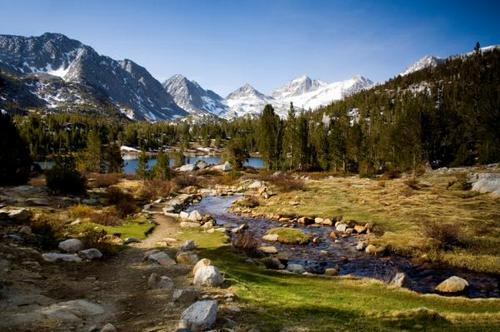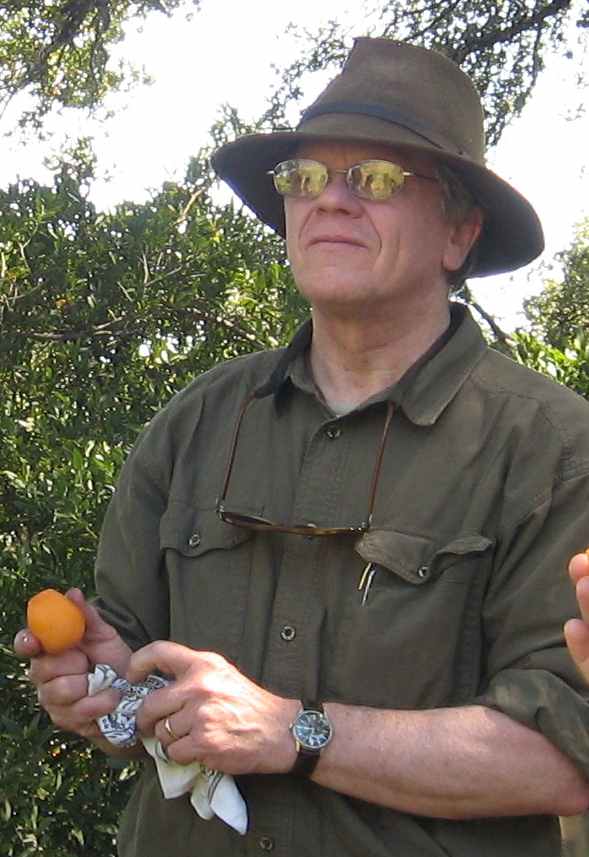A Deep Ecology Perspective and Critique of the
Mainstream Environmental Movement
Without sufficient contact and interaction with nature, and without a worldview sufficiently open to it, we are not able to form relationships with communities of life around us, meaning we are unable to live in solidarity with them. Yet the world is full of wonders still and of possibilities for new awakenings to the word of God coming to expression there—of worldviews reoriented to the communities that sustain life.
By David Siegenthaler
 View and Print as PDF.
View and Print as PDF.

The day breaks crisp and clear, with delicate scents of pine infused now and then with hints of vanilla and moist meadow. The air is thin at 8,000 feet in the Sierra Nevada, but fresh and exhilarating. Ravens broadcast their calls in conversation with their kin at various treetops across a wide swath of forest, interspersed with wet, sub-alpine meadows. Occasionally, the faint and melodic, rising and falling, flute-like song of a thrush echoes within the dense cover of the lodgepole pine and red fir forest. Golden mantled ground squirrels busily dart to and fro in their frenzy of gathering and stashing. Ants emerge from their mounds to begin their collecting, scouting, and cultivating chores in well-organized synchronism. If one is attentive, open, and patient, myriad other activities by the indigenous populations can be noticed. The warming rays of golden sunlight awaken the plant and animal community; the sublime beauty of forms and textures, smells, and sounds, prompts an immediate sensation of comfort, kinship, and belonging. The day and place is stimulating and inviting; of the sort that prompts many to exclaim it is sacred, and to feel their part in it is sacred too.
Thus the morning’s Earthwalk is well attended by an enthusiastic group of young people—eager to explore, close-up, the minute world of wonder on the meadow edge of the forest. The walk involves full sensory participation and down-on-your-hands-and-knees contact with the earth.[1] Not surprisingly, a couple children from the nearby campground see the activity and implore the leader to allow them to join in the fun. They are naturals, as are most youngsters, in noticing fine details, and from what at first may seem ordinary, to discover strange and exciting things. They love the group’s process and the joyful connection with this subalpine wonderland.
___________________________________________
The environmental movement has, by and large, assumed that, if the facts are known, a particular ethical response will ensue. A teaching approach is not sufficient. First-hand contact with the complex communities of life around us can provide that revelatory breakthrough that allows understanding to follow.
___________________________________________
Until, that is, the parents of the two come to retrieve them. The young explorers are harshly admonished to get up off the ground so they don’t get their clothes any dirtier (they were already possibly “ruined”), and to return at once to their campsite. With sadness, they leave the earthwalk, which continues without them. At the walk’s conclusion a short while later, as the other participants on the walk return along the path, the two who had been reigned-in can be seen emotionlessly watching a video on the picnic table outside their family’s RV, while a gasoline generator blares and pumps out exhaust fumes in the background.
It can probably be safely asserted that the parents, who did not want their children to have too much contact with “dirt” and nature, did not receive the hospitable tidings of the day and place in the same way, or in the same spirit, as first described here. What causes this clash of different worldviews? How can the same world be experienced in such different terms? And if we agree that there is a problem represented by the attitude that people should not be too enamored with the natural world, what would we say is the proper solution?
So far, the proposed solution, at least in the United States and from those who agree there is a problem, has been a presentation of facts. The environmental movement has, by and large, assumed that, if the facts are known, a particular ethical response will ensue. The facts are assumed to carry a moral valence. But the same scientific understandings that undergird the new environmentalism also inform others of how to more effectively manipulate the earth to extract resources and attain other ends. It’s not even clear that the environmentalists and the industrialist are very far apart in their worldviews.
If the main values of the U.S. society may be discerned from the persistent structural features of our country, it is questionable whether the environmental movement presents a serious challenge to an economy based upon accumulation of wealth for some, a population of laborers (often foreign, migrant, or otherwise rendered powerless) willing to accept a lot less, and an increasingly technology and luxury infatuated population of consumers. Indeed, the environmentalists themselves (ourselves!) predominantly represent privilege and wealth. Given the present trajectory, perhaps the most we can expect our environmentally sensitive scientific knowledge to achieve is a stay of execution: industrial production that is survivable for the primary consumer populations for a while longer, and increased wealth for those businesses that are capable of appealing to the “green” market.
This is not meant to brush everyone with the same broad, caricatured strokes as either exploiter or exploited. Our feelings and sensitivities, knowledge and convictions, fall along a broad spectrum. But it is meant to suggest that the problem goes much deeper than our environmentally informed educational, economic, religious, and political systems have been able to address thus far. That is also not to say that the environmental movement has no potential to effect further change. But the persistence of institutions that contribute to social and ecological injustice is troubling.
The rise of obesity and diabetes (including in young children) due to increasingly sedentary lives and unhealthy nutrition is troubling. The replacement of “biophilia”, which Edward O. Wilson described as “the connections that human beings subconsciously seek with the rest of life,”[2] with videophilia, “the new human tendency to focus on sedentary activities involving electronic media,”[3] is troubling. And the apocalyptic, violent, militaristic, and individual strength-glorifying content of much of the video material is equally troubling. It is also worrisome that, as a recent poll indicated, although ecological literacy has increased over the last 40 years in terms of introducing a recognizable ecological vocabulary into the English lexicon, the meanings and implications associated with that literacy have not been internalized enough to translate into understanding basic ecological challenges we face today, such as global climate change, habitat loss, pollution, water and food scarcity, and overpopulation.[4] These persistent trends in American life suggest that the environmental movement has not had a serious-enough effect on the American culture. Our core orientations to the world are persistent in leading us astray. We might do well to consider that the problem is not merely a matter of getting the facts right. Although they entail both intellectual and visceral dimensions, the issue lies at the core of our self-understanding and worldview.
___________________________________________
The church has a vital role to play still. What better place than the one that is trained to reflect on questions of ultimate significance? What better perspective than one that affirms the underlying structure of the universe as being radically inclusive love, and that calls us to support the poor and disenfranchised, the voiceless, and the injured?
___________________________________________
“We achieve the presence of the world around us,” claims Alva Noë.[5] This is to say that we play an active role in the way in which the world is present for us. Our core concepts about the world and our place in it function to interpret our sensory data. Experience and perception are the result, therefore, of both the presence of the world around us, and our own processes, conscious and subconscious, of making sense of it. The “sense” that we make is grounded in the core metaphors that literally define how we see the world—that inform our concepts of how the world works, what it means, and what part we play in it. That core metaphorical structure is built upon by further experience. It is mutable, but for the most part we tend to adhere to our worldviews, and we interpret our experience in ways that cohere with our core conceptual structures.
George Lakoff helped shed light on this phenomenon in his analysis of liberal versus conservative worldviews. The former, he claimed, used a core metaphor of nurturing parent, while the latter used that of a strict father. Unless one understood the underlying terms of the language being used and the metaphors employed, one could not counter the arguments effectively (he was speaking to liberals who struggled to contend in a conservative framed debate). He claimed that people tend to vote according to their identities and values, even when it could be contrary to their own economic self-interest.[6]
H. Richard Niebuhr claimed that there are two primary symbols that guide our response to what we face in the world: that of humans as makers, and that of humans as citizens.[7] Based on the evidence of our current situation, it would seem that the primary symbol guiding our interpretation of the world is that of humans as makers, and that it entails the notion that the world is given for our use, or at least that we are of another order than the rest of the earth community. This notion is pervasive, even in the symbols of steward and gardener, despite suggesting that our manipulations are to be in the service of more than just ourselves.[8]
How, then, do core symbols change? How do we alter the core perceptual tools we use to interact with the world around us? A teaching approach is not sufficient. First-hand contact with the complex communities of life around us can, for those who are still open to it, provide that revelatory breakthrough that allows understanding to follow. Understanding follows love, which both lays the groundwork for deeper knowledge gained through respectful interaction, and in turn is also increased in the process. The revelation may be marked by an exclamation of “this place is sacred”, or it may be just a moment of breathtaking wonder and gratitude, but such experiences are key to building the committed relationships we need. Most children are born with such capacity for wonder. It takes misdirected core convictions to kill it.
Think, then, what the implications are for a society plagued by “nature deficit disorder” if you believe humans to be inextricably linked to the natural processes, systems, and communities of life as responsible participants. Instead of the intersubjectivity we should be seeking, we get the objectification that is inevitably myopic, and leads to exploitation and manipulation rather than solidarity.
One source of hope for deep ecologists, in the struggle to effect radical reform, is similar to the hope held by those of various faiths: that it is still possible to experience the wonder and grace of a world that, despite all the hurt, is still marvelous and full of possibility. We cannot always orchestrate epiphanies to achieve the revelation that is needed, but we can try—and the good news is that, after all, it is not up to us to accomplish it fully; grace comes to us freely—it just needs our openness and ability to recognize it. What we can offer to the world is our service as responsible participants.
The church has a vital role to play still. What better place than the one that is trained to reflect on questions of ultimate significance? What better perspective than one that affirms the underlying structure of the universe as being radically inclusive love, and that calls us to support the poor and disenfranchised, the voiceless, and the injured? We must know the world through the lens of love—only then can we attain the subject-to-subject understanding that deepens itself. We must all love the places where we live—not only do the distant large wilderness areas depend on it, but so do we all, no matter where we are or of what species.
Read more articles like this one in the Nov 2012–Jan 2013 issue, “Hope for Eco-Activists: Discovering an Environmental Faith“
Notes
[1] For information on Earthwalks, as well as their educational philosophy, and the deep ecology perspective they represent, see Steve Van Matre, Earth Education: A New Beginning (1990), Interpretive Design and The Dance of Experience (2008), published by The Institute For Earth Education, Greenville, West Virginia.
[2] Edward O. Wilson, Biophilia; Cambridge: Harvard University Press, 1984.
[3] Oliver R. W. Pergams and Patricia A. Zaradic, “Is Love of Nature in the U.S. Becoming Love of Electronic Media? 16-year Downtrend in National Park Visits Explained by Watching Movies, Playing Video Games, Internet Use, and Oil Prices.” Journal of Environmental Management 80 (2006): 387-393. See also their website at http://www.videophilia.org/; accessed 9/2/2012.
[4] Kevin Coyle, Environmental Literacy in America: What Ten Years of NEETF/Roper Research and Related Studies Say About Environmental Literacy in the U.S. (Washington DC: The National Environmental Education & Training Foundation; 2005). The findings of this research suggest that the language of ecology and general ecological concern is much more pervasive on a superficial level than it was thirty years ago, however ecological literacy at the level of deep understanding remains sorely lacking.
[5] Alva Noë in interview with Michael Krasny on “Forum”, KQED radio, San Francisco, California, August 20, 2012. See also Alva Noë, Varieties of Presence; Cambridge: Harvard University Press, 2012.
[6] George Lakoff, Moral Politics: How Liberals and Conservatives Think. Chicago: University of Chicago Press, 2002. See also, Don’t Think of an Elephant!: Know Your Values and Frame the Debate–The Essential Guide for Progressives (2004); Metaphors We Live By (1980); and Philosophy In The Flesh (1999).
[7] H. Richard Niebuhr, The Responsible Self: An Essay in Christian Moral Philosophy, New York: Harper & Row, 1963.
[8] In The Human Role In Nature: A Case Study Analysis of Yosemite Planning Processes Employing H. Richard Niebuhr’s Symbol of Responsibility (David Siegenthaler, Ph.D. diss., The Graduate Theological Union, Berkeley, California, 2010), I suggested a new symbol for the human role, that of “pro-Creator.” That symbol is meant to acknowledge deep ecological realities with the affirmation that God intended humans to be responsible participants in the Earth community, while affirming our need to constantly seek to discern and support God’s living word coming to expression in the world.
David Siegenthaler is an eco-justice minister in San Francisco Presbytery. He is a program officer for several state and local assistance programs for the western region of the National Park Service. His previous work included rangering, public interest work, community organizing, natural resource management, and interpretive planning and design. His educational background includes a B.A. is in sociology, M.S. in environmental resource administration/interpretation, M.Div., and a Ph.D. in systematic and philosophical theology.Banner photo by Chris Gilbert.







Unbound Social